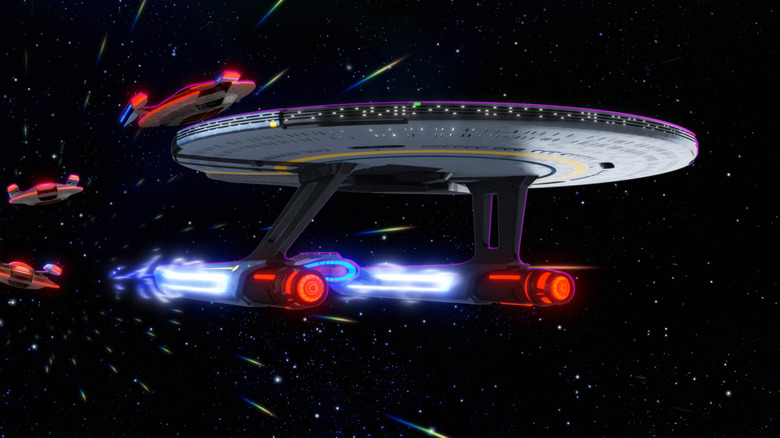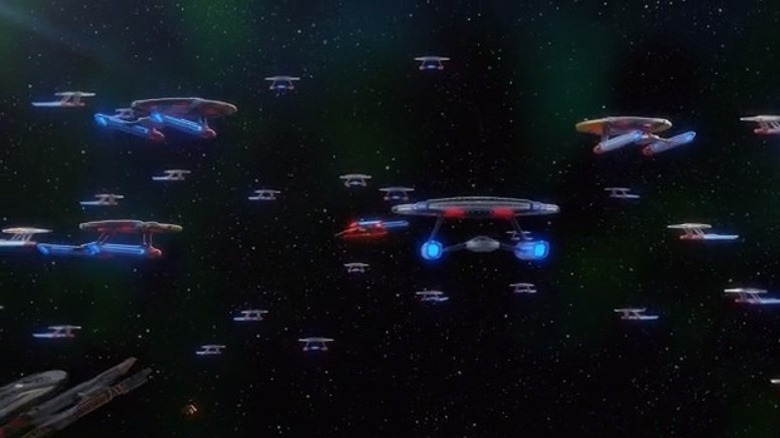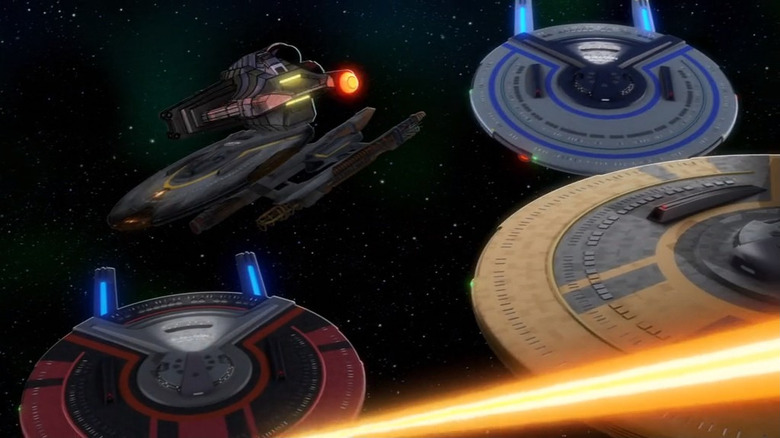Naming Ships Is A 'Stressful' Job For The Showrunner Of Star Trek: Lower Decks
Mike McMahan, the creator of "Star Trek: Lower Decks" has been coy about the actual size of his show's central vessel, the U.S.S. Cerritos. Given the ship's status as a secondary utility vehicle, viewers might come to believe that the ship is tiny, perhaps even one of the smallest in the fleet. However, some recent expanded universe lore — particularly, the Eaglemoss scale model of the Cerritos — have declared the ship to be about as long as the U.S.S. Enterprise-E. For non-Trekkies, that's actually quite long.
McMahan once confessed to Inverse that the size of the Cerritos actually changed thanks to his show's increased animation budget. In the first season of "Lower Decks," animators were only able to include so many windows on the ship exterior. When the budget increased, detail on the ship became more elaborate, and more windows were added. More windows, however, meant more floors. All of a sudden, the Cerritos was pretty enormous.
The Cerritos belongs to a class of starships called the California class. It's constructed of a large saucer section with its engines and drive section located far below, tethered only by a pair of thin connecting pylons. The upper decks and lower decks are starkly separated, enhancing the four lead characters' isolation from the action. Each of the ships belonging to the California class are named after cities in California, leading to additional jokes. Cerritos, CA is not the most auspicious town. Its citizens would agree.
KCRU, Oxnard/Ventura. KCRY, Mojave/Antelope Valley ...
Throughout "Lower Decks," the Cerritos has occasionally run into other California-class vessels, each bearing the name of a dinky city or tourist town far outside of the state's better-known metropoles. So far, audiences have seen the U.S.S. Merced, the U.S.S. Solvang, and the U.S.S. Carlsbad. The finale of the show's third season featured a grand support fleet of nothing but California-class ships, and the state's residents likely got a good chuckle over the fact that there are ships named the U.S.S. Pacific Palisades, the U.S.S. Fresno, the U.S.S. West Covina, the U.S.S. Inglewood, and the U.S.S. Anaheim. This author was born in Santa Monica, CA, and felt elated that there was also a U.S.S. Santa Monica.
In a recent interview with ComicBook.com, McMahan admitted that choosing the right California towns after which to name his fleet was something of a chore. Production on "Lower Decks" takes place in southern California, so the writers on the show no doubt had a lot of opinions on the matter. When asked how much of the California class had been planned, McMahan said:
"I don't have a list. I only have a list of the ones that we've been seeing as we're going. And I would love there to be lots of state name ships. I'll tell you, there was a lot of discussion about what cities made it into the California class that we rattle off at the end there, which was really fun. I also liked having the Van Citters ship come in because I love John Van Citters, who's been such an ally and such an amazing partner on the show. So it is fun, naming ships, but it's also very stressful. I never want to mess it up."
Long Beach freeway, Firestone exit, South Gate ...
John Van Citters is a name well known to deep-cut Trekkies, but may not be entirely familiar to civilians. He was the author of the 2003 "Starfleet Operations Manual" that served as a supplement to the sprawling "Star Trek" role-playing game. The manual contains deeply meticulous details as to the operations of ships and the responsibilities of Starfleet crew members as they had never been detailed on any of the shows. "Star Trek" lives and dies by its minutiae, and Van Citters provided an overwhelming amount. Starting in 2006, Van Citters has been head of CBS Consumer Products division, overseeing Trek merchandise, and currently works as the Vice President of all "Star Trek" brand management. He also spearheaded the effort to update the out-of-date "Star Trek Encyclopedia" in 2016. That McMahan thought to name a ship after Van Citters was incredibly thoughtful.
Of course, little nods to crew and creators have long been a Trek tradition. The plaque on the bridge of the Enterprise-D on "Star Trek: The Next Generation" lists a number of Starfleet admirals who oversaw the commission of the ship, and they are all names of executives on the show, starting with Adm. Gene Roddenberry. Rick Sternbach and Michal Okuda are on there as well, and any good Trekkie likely had the "Technical Manual" the pair once authored with Denise Okuda.
I saw it up close.


